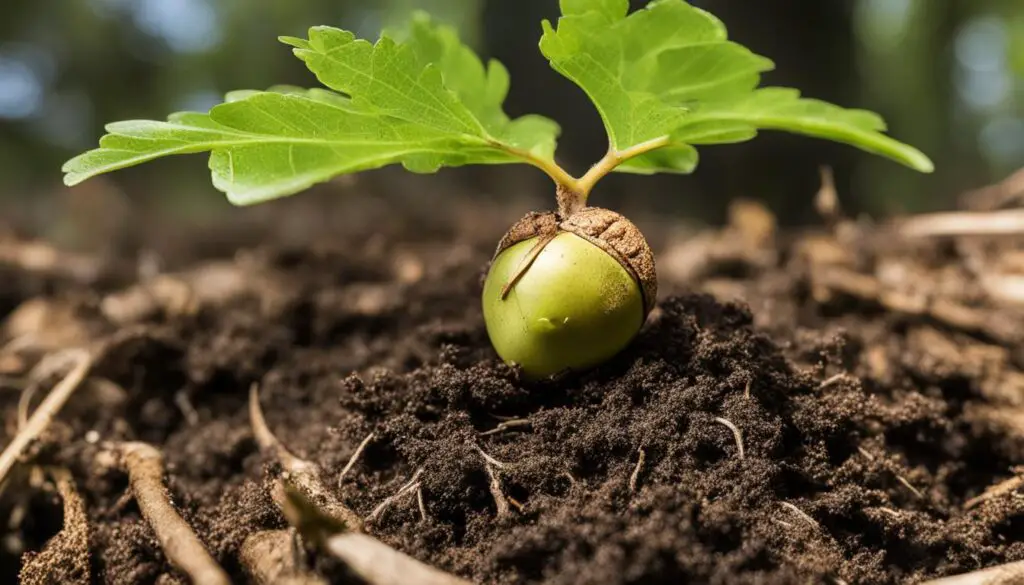Oak trees are a symbol of strength and endurance, and the white oak tree (Quercus alba) is no exception. With over 600 species of oak trees, the growth rate of white oaks can vary. The growth time of oak trees is influenced by factors such as environmental conditions, oak tree species, site conditions, and maintenance practices. On average, it takes oak trees about 20 to 50 years to reach maturity and achieve their full size. However, some oak species can take longer, spanning several decades or even centuries to fully mature. Understanding these growth factors and timelines is key to nurturing and appreciating these magnificent trees.
Key Takeaways:
- White oak trees have a variable growth rate depending on various factors.
- The average growth time for oak trees is around 20 to 50 years.
- Environmental conditions, oak tree species, site conditions, and maintenance practices impact oak tree growth.
- Some oak species may take several decades or even centuries to reach maturity.
- Nurturing and appreciating oak trees requires understanding their growth factors and timelines.
Environmental Conditions and Oak Tree Growth
The growth of white oak trees is significantly influenced by environmental conditions. Different oak tree species thrive under specific climate and soil types, making it essential to understand the factors that affect their growth rate in different climates.
White oak trees have varying preferences for climate and soil conditions. While some species prefer temperate climates, others can tolerate colder or warmer environments. The availability of sunlight, water, and nutrients in the soil also play a crucial role in the growth rate of white oaks.
To ensure optimal growth in different climates, it is necessary to consider the specific environmental needs of white oak trees. By providing the ideal climate, soil, and nutrient conditions, you can encourage healthy growth and development.
Factors Affecting White Oak Tree Growth Rate:
- Climate: Different oak species thrive in different climate ranges, with some preferring temperate climates and others showing tolerance to colder or warmer conditions.
- Soil Type: White oak trees have specific soil preferences, and factors like fertility, drainage, and pH levels can impact their growth.
- Sunlight: Access to sufficient sunlight is crucial for photosynthesis and overall tree health.
- Water: Adequate water availability allows white oak trees to absorb nutrients and maintain optimal growth.
- Nutrient Availability: The presence of essential nutrients in the soil influences the growth rate and overall health of white oaks.
Understanding the impact of environmental conditions on white oak tree growth is essential for successful cultivation in various climates. By providing the appropriate climate, soil, sunlight, water, and nutrient conditions, you can promote healthy growth and enjoy the beauty of these majestic trees.
Oak Tree Species and Growth Characteristics
Each oak tree species has its own unique growth rate and characteristics. When planning and nurturing an oak tree, it is important to consider the growth patterns and timelines of different white oak tree varieties.
Fastest Growing White Oak Tree Varieties
While some oak tree species have a faster growth rate compared to others, it is worth noting that even the fastest growing white oak trees still require several decades to reach maturity. Here are some of the fastest growing white oak tree varieties:
| White Oak Tree Variety | Growth Rate |
|---|---|
| Pin Oak | Relatively fast |
| Swamp White Oak | Moderate |
| Bur Oak | Moderate to fast |
Note: These oak tree varieties are known for their relatively faster growth rate, but they still require several decades to mature.
White Oak Tree Growth Patterns
White oak trees, like other oak tree species, have a slower growth rate compared to some fast-growing varieties. It may take several decades for white oak trees to reach their full maturity. However, this slow growth rate contributes to the overall strength and longevity of these magnificent trees.
Site Conditions and Oak Tree Growth
The quality of the planting site plays a significant role in the growth of white oak trees. Several factors can affect the quality of the planting site and subsequently impact the growth and development of oak trees.
Soil Quality: The fertility of the soil is crucial for providing essential nutrients to the oak tree’s roots. Rich, well-drained soil promotes healthy root development and enables the tree to access the necessary nutrients for growth. Soil pH levels also play a vital role, as white oak trees typically prefer slightly acidic to neutral soil conditions.
Drainage: Adequate drainage is essential to prevent waterlogging, which can lead to root rot and hinder the tree’s growth. Poorly drained soil can suffocate the roots, depriving them of oxygen and hindering their ability to absorb nutrients.
Light Exposure: Oak trees, like most plants, require an optimal amount of sunlight to facilitate photosynthesis and promote healthy growth. Choosing a site with ample sunlight exposure ensures that the oak tree receives the energy it needs to thrive.
Space for Root Development: Providing enough space for the roots to spread out is crucial for oak tree growth. A congested planting site can restrict root growth and limit the tree’s ability to access available nutrients and water.
To ensure the best growth conditions for oak trees, it is essential to choose a site with fertile soil, proper drainage, ample sunlight exposure, and sufficient space for root development.
Next, let’s explore the various maintenance practices that contribute to promoting oak tree growth and ensuring their long-term health.

Maintenance Practices for Oak Tree Growth
Proper care and maintenance are essential for promoting the growth and overall health of white oak trees. By following a few key tips and practices, you can ensure that your oak trees thrive and reach their full potential. Here are some maintenance practices to consider:
Regular Watering
Consistent watering is crucial for oak tree growth, especially during dry periods. Adequate water supply helps the trees establish their roots, absorb nutrients, and maintain overall health. It is important to provide deep watering rather than frequent shallow watering to encourage deeper root growth.
Mulching
Mulching around the base of your oak trees offers several benefits. It helps conserve moisture, regulate soil temperature, and inhibit weed growth. Apply a layer of organic mulch, such as wood chips or bark, around the tree, keeping it a few inches away from the trunk to avoid moisture accumulation or pest issues.
Root Space
Allowing ample space for root expansion is essential for the healthy development of oak trees. Avoid planting other vegetation too close to the tree, as it can compete for nutrients and hinder root growth. Additionally, avoid compacting the soil around the roots, as it restricts oxygen flow and can lead to root damage.
Pruning
Regular pruning helps maintain the shape and structure of oak trees while promoting healthy growth. Remove any dead, diseased, or damaged branches, and thin out crowded areas to improve overall tree health. It is best to prune during the dormant season to minimize stress on the tree.
Pest and Disease Management
Vigilance in addressing pest or disease issues is crucial for ensuring the continued health and vitality of oak trees. Regularly inspect your trees for signs of pests, such as insect infestations or diseases, and take appropriate measures to control them. Consult with a local arborist or extension service for specific pest and disease management recommendations.
| Practices | Benefits |
|---|---|
| Regular watering | Ensures proper hydration and nutrient absorption |
| Mulching | Conserves moisture, regulates soil temperature, prevents weed growth |
| Root Space | Allows for healthy root expansion and nutrient uptake |
| Pruning | Maintains tree shape, removes dead or damaged branches |
| Pest and Disease Management | Prevents and controls infestations and diseases |
Growth Stages of Oak Trees
Oak trees go through distinct growth stages throughout their lifespan. Understanding these stages is essential for appreciating the journey and transformation of these remarkable trees.
1. Germination and Seedling Stage:
The germination and seedling stage is the beginning of an oak tree’s life. It starts when an acorn takes root in the ground, establishing its root system. During this stage, the oak tree relies on the stored energy within the acorn to grow. It is a critical period for the tree to develop a strong foundation for future growth.
2. Young Sapling Stage:
As the oak tree grows above ground, it enters the young sapling stage. During this stage, the tree begins to produce more leaves and branches, expanding its canopy. The sapling stage is characterized by rapid growth and increased photosynthesis, enabling the oak tree to gather more energy from the sun and continue its development.
3. Mature Tree Stage:
After years of growth, the oak tree reaches the mature tree stage. This is when the tree reaches its full height, spreading its branches wide. Mature oak trees play a vital role in the ecosystem as they provide food and habitat for various wildlife. They also contribute to the overall biodiversity and stability of the surrounding environment.
Longevity of Oak Trees:
Oak trees are known for their longevity. They can live for several decades or even centuries if provided with optimal growing conditions. Their longevity allows them to provide shade, shelter, and support to their ecosystem for many years.

| Growth Stage | Description |
|---|---|
| Germination and Seedling | Beginning of an oak tree’s life. Root system establishment and reliance on stored energy from the acorn. |
| Young Sapling | Growth above ground. Increased leaf and branch production. |
| Mature Tree | Full height, wide branches. Contribution to the ecosystem. |
| Longevity | Several decades to centuries, supporting their ecosystem for many years. |
Promoting Healthy Oak Tree Growth
To ensure the longevity and healthy growth of white oak trees, it’s important to follow a few key tips and practices. By providing the right environment and care, you can foster strong, vibrant oak trees that will thrive for years to come.
To begin with, choose a suitable location for planting your oak tree. Look for an area with well-draining soil and ample sunlight. Oak trees require good air circulation and sunlight exposure to grow optimally.
Regular watering is essential, especially during dry periods. Adequate watering helps oak trees stay hydrated and prevents stress from drought. Be sure to water deeply, allowing the moisture to penetrate the soil and reach the roots.
Did you know? Overwatering can be just as harmful as underwatering. Maintain a balanced watering schedule to avoid excessive moisture and root rot.
In addition to proper watering, applying organic mulch around the base of the tree can offer several benefits. Mulch helps retain moisture, moderates soil temperature, and suppresses weed growth. It also acts as a protective layer, preventing damage to the delicate root system.
Pro Tip: Use a layer of organic mulch that is approximately 2-4 inches thick, ensuring it does not touch the trunk of the tree. This will help prevent moisture-related issues and create an ideal growing environment for your oak tree.
Regular pruning is another important aspect of oak tree care. Prune selectively to remove dead, diseased, or crossing branches. This promotes proper airflow and encourages healthy growth. Avoid excessive pruning, as it can weaken the tree and make it susceptible to diseases or pests.
 Consult with a local arborist or horticulturist for guidance on pruning techniques specific to white oak trees. They can provide valuable insights and ensure the best care for your trees.
Consult with a local arborist or horticulturist for guidance on pruning techniques specific to white oak trees. They can provide valuable insights and ensure the best care for your trees.
Another crucial aspect of oak tree care is addressing pest and disease issues promptly. Regularly inspect your oak trees for signs of pests, such as borers or aphids, and diseases like oak wilt or powdery mildew. Consult with professionals if you notice any concerning symptoms or need assistance in identifying and treating these issues.
Lastly, consulting with local arborists or horticulturists for advice on fertilizer and nutrient needs can further enhance the growth and vitality of your oak trees. These professionals can recommend the right type and amount of fertilizer, tailored to the specific needs of white oak trees.
By following these tips and practices, you can create an environment that promotes healthy oak tree growth. With proper care, your oak trees will flourish, adding beauty and shade to your surroundings for generations to come.
Appreciating the Beauty and Patience of Oak Tree Growth
Understanding the growth time of oak trees allows us to appreciate the journey and process of their development. From humble beginnings as acorns to their grand stature as mature trees, oak trees enrich the environment and provide habitat for various wildlife. The slow growth of oak trees reminds us of their resilience and the importance of patience when nurturing these remarkable beings. Embracing the beauty and patience that comes with growing oak trees allows us to witness the rewards of nurturing a living legacy that will stand tall for generations to come.

Conclusion
White oak trees possess a timeless beauty and embody strength and endurance. By understanding the growth rate and factors that influence their development, we can cultivate and appreciate these magnificent trees successfully. With proper care, maintenance, and knowledge of growth timelines, white oak trees can thrive, offering shade, shelter, and habitat for wildlife. The nurturing process of these remarkable beings demands patience and dedication, but it is rewarded by their gradual transformation and long-lasting presence.
Recognizing the significance of white oak tree growth rate enables us to appreciate the journey and complexity of their development. From the humble beginnings as acorns to their grand stature as mature trees, white oaks enrich their environment, leaving a lasting legacy. As we witness their slow growth, we are reminded of their resilience and the importance of cultivating these living treasures with patience and care. Embracing the beauty and patience intrinsic to oak tree growth allows us to witness nature’s remarkable ability to create enduring wonders.
In conclusion, the growth rate of white oak trees plays a critical role in their successful cultivation. By providing the essential care, maintenance, and understanding of growth timelines, we can ensure their optimal development. Appreciating the gradual transformation and longevity of these majestic trees is a testament to the rewards that come with nurturing nature’s awe-inspiring creations.
FAQ
How fast do white oak trees grow?
The growth rate of white oak trees can vary depending on factors such as environmental conditions and species. On average, it takes white oak trees about 20 to 50 years to reach maturity and achieve their full size.
What factors affect the growth rate of white oak trees?
The growth rate of white oak trees is influenced by factors such as environmental conditions, oak tree species, site conditions, and maintenance practices.
How long does it take for oak trees to reach maturity?
On average, oak trees take about 20 to 50 years to reach maturity. However, some oak species can take longer, spanning several decades or even centuries to fully mature.
What are the fastest growing white oak tree varieties?
Some of the fastest growing white oak tree varieties include the pin oak. These varieties can reach maturity within a few decades.
What are the growth patterns of white oak trees?
White oak trees have a slower growth rate compared to some other oak species. They may take several decades to mature and reach their full size.
What factors affect the growth of white oak trees in different climates?
The growth of white oak trees in different climates is influenced by factors such as temperature, soil type, sunlight availability, water availability, and nutrient levels in the soil.
What role do site conditions play in the growth of white oak trees?
Site conditions, such as soil fertility, drainage, and pH levels, play a significant role in the growth of white oak trees. Providing optimal conditions for root establishment and nutrient access is important for their healthy development.
What maintenance practices are important for promoting the growth of white oak trees?
Proper care and maintenance practices, such as regular watering, mulching, pruning, and addressing pest or disease issues, are essential for promoting the growth of white oak trees.
What are the growth stages of oak trees?
Oak trees go through distinct growth stages, including germination and seedling stage, young sapling stage, and mature tree stage. These stages involve the development of the oak tree’s root system, above-ground growth, and the tree’s contribution to the surrounding ecosystem.
How can I promote healthy growth for white oak trees?
To promote healthy growth for white oak trees, plant them in a suitable location with well-draining soil and ample sunlight. Provide regular watering, organic mulch, selective pruning, and address any pests or diseases as needed. Consult with local experts for fertilizer and nutrient needs.
What is the journey of oak tree growth like?
The growth timeline of oak trees involves a gradual transformation from acorns to grand, mature trees. The slow growth of oak trees reminds us of their resilience and the importance of patience when nurturing these remarkable beings.
Can oak trees live for a long time?
Yes, oak trees are known for their longevity. They often live for several decades or even centuries, supporting their ecosystem and providing shade, shelter, and habitat for diverse wildlife.

